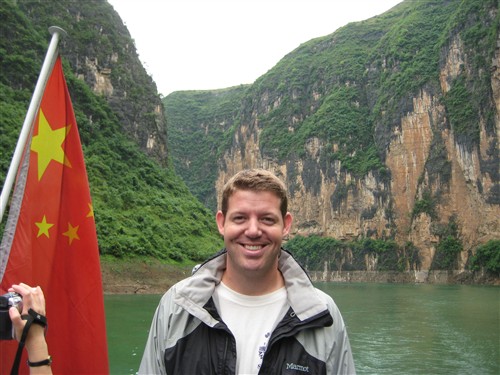 A cruise on the Yangzi River had been touted as a must-do in China and, although we had so recently cruised in Halong Bay in Vietnam, our curiosity got the best of us. If you don’t speak Chinese, there is disappointingly scarce information available regarding the cruises, the highlight of which is the opportunity to view the famed Three Gorges. From our hostel in Xi’an, we were able to book cruises but the staff had little knowledge of the details. The two options: an international cruise ship – very expensive; or a Chinese cruise ship for less than a third of the price. The international cruise had provided a snazzy color brochure; the Chinese ship was a total mystery. Your Honor, if it pleases the court, I would like the record to reflect that I lobbied against the Yangzi River cruise altogether.
A cruise on the Yangzi River had been touted as a must-do in China and, although we had so recently cruised in Halong Bay in Vietnam, our curiosity got the best of us. If you don’t speak Chinese, there is disappointingly scarce information available regarding the cruises, the highlight of which is the opportunity to view the famed Three Gorges. From our hostel in Xi’an, we were able to book cruises but the staff had little knowledge of the details. The two options: an international cruise ship – very expensive; or a Chinese cruise ship for less than a third of the price. The international cruise had provided a snazzy color brochure; the Chinese ship was a total mystery. Your Honor, if it pleases the court, I would like the record to reflect that I lobbied against the Yangzi River cruise altogether.
Despite the lukewarmth of my expressions, Aaron was quite determined and, since most of our boat experiences have been generally enjoyable, I acquiesced. With the international ship being understatedly cost prohibitive, we agreed on a second class cabin on the Chinese ship, the fare for which excluded all meals, drinks and excursions. We paid a thirty percent deposit at the hostel in Xi’an with the balance due the next day in Chongqing.
The sleeper train from Xi’an to Chongqing was like a ghost train. Not only did we have our entire four-bed cabin to ourselves but there was only one other passenger in the whole car and we didn’t even realize he was there until it was time to get off the train. The eleven-hour journey left us rested and we met our local booking agent, John, at the train station in Chongqing. He drove us, along with two young British girls, to his mini-hostel – John’s Cozy Nest – to spend the day. The eighth floor “nest” overlooking the Yangzi lived up to its name with a comfortable sitting area, cheap refreshments, free Wi-Fi, a shower, and John himself who was a generous wealth of knowledge. He spoke decent English and explained the details of the cruise, the prices and significance of the optional land excursions, and the transportation options at the tail end of the cruise. We would later discover that the English ended with John and he wasn’t coming with us.
We were happy to find that four British travelers – Eloise, Kayleigh, Michael and Katie – would be cruising with us. A wave of relief washed over us upon hearing this news as we half-expected to be the only foreigners on the Chinese cruise. Eloise and Kayleigh would share a second class cabin with us while Michael and Katie planned to endure a third class cabin. We made a trip to the supermarket in Chongqing to stock up on snacks, unsure about the canteen aboard the ship.
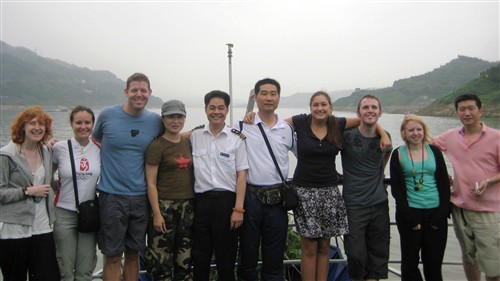
When 6:30 rolled around, John instructed the six of us to follow his brother to the ship. With our heavy packs and grocery bags in tow, we headed toward the parking lot but, rather than loading us into the mini-bus, John’s brother led us on a twenty-minute hike through the rain-soaked streets of Chongqing to the loading dock. There we were handed off to another Chinese man who handed us off to a Chinese woman who led us onto our ship amid a traffic jam of Chinese passengers, all with arms full of grocery bags.
The first things I noticed, as we boarded our Chinese cruise ship were the rippled, rusty painted metal deck and the foul stench of rotting fish and dirty water. The corridors were dim and the surfaces dingy. The experience recalled that same sense of innate hesitation that I felt upon boarding Captain Barracuda’s ship on the island of Lamu – my gut told me that something was fishy; that we should take the financial loss and get off the ship immediately. I voiced this to my husband who reacted with a chuckle.
The woman unlocked our cabin door and Aaron and I walked inside along with Eloise and Kaleigh. The cabin was small and cramped for four people with large backpacks, but we were all happy just to drop our bags. By some miracle, our claustrophobic cell of a washroom had a western toilet. The shower nozzle, which was almost directly above the toilet, initially spewed brown water. It was not a promising start but we were determined to make the best of it. The cabin was stuffy because the air conditioner was just sputtering to life so we congregated outside our door, looking out over the murky brown water into a dense fog.
Soon, a woman approached our group and beckoned us to follow her. She led us to the bow of the ship, into a small glassed-in lounge with a far door leading to an outer deck with blue plastic patio furniture. There were two middle-aged Chinese men chain-smoking in the lounge, working it into a hot box of cancer. This was the VIP area of the ship and the price of admission was 70 Yuan ($10), which included chairs, lung disease and all-you-can-drink Chinese tea. We all declined and returned to our rail, laughing all the way at the idea of paying for a VIP lounge when surely there was a furnished upper deck.
We decided to take a lap around the ship to explore its amenities. We spotted an indoor bar at the stern that would soon be packed with middle-aged Chinese chimneys, attended by a lone barman with black teeth. As we circled the ship, looking for the stairs to the upper deck, we soon came to the conclusion that there was no upper deck. We quickly deduced that, short of paying the VIP admission, there was literally no place for us to sit outside of our cramped, humid cabin. Since the others in our little group seemed adamant against the VIP idea, we all spent the remainder of the evening sitting on the rusted floor of the three-foot-wide walkway that spanned the perimeter of our deck. I nodded off to sleep that night knowing that I would not last the next three days without a chair.
Aaron and I woke early the next morning, sweating buckets because our air conditioner mysteriously stopped working around 2am. Also, the cleaning staff pounded on our cabin door at 6:45am to empty our trash. Both of these petty annoyances would occur on each morning of our cruise. We bought admission into the VIP lounge, encouraging the rest of our group to do the same. It was not the price of admission that we all struggled with but rather the principle of the matter. It is bad enough to pay a lot of money for a cruise that includes nothing but dingy, substandard accommodation but to have to pay more just for a place to sit is ludicrous. Eventually, everyone gave in and joined us. The first full day of our cruise was rainy and foggy and we passed the bulk of it by playing cards and attempting to visit over the single VIP television which blasted Chinese soap operas all day.
Having sustained ourselves on instant noodle cups, fruit and packaged snacks all day, we decided to try the canteen for dinner. The menu was entirely in Chinese, with no pictures, but we managed to order several dishes to share. We had kept our expectations very low and were shocked to find the food to be excellent. We all agreed that dinner was the highlight (the only light) of our Chinese cruise so far and were already looking forward to dinner the next night. By the way, many Brits refer to dinner as tea, which was initially confusing until we worked out the distinction. Breakfast is breakfast. Lunch is dinner. And dinner is tea. Also, we have found all of the Brits that we’ve met along the way to be exceedingly proper and possessing exquisite manners, which is decidedly endearing. We’ve not yet met a Brit that we didn’t like.
 On the second morning, we cruised through Qutang Gorge, the first of the Three Gorges. The day was foggy and it was raining again – the visibility left much to be desired – but the Chinese passengers flooded the outer VIP deck nonetheless to pose for endless photos. All of our group donned their rain gear and wandered outside to join the melee…all except for me. I simply didn’t find the view interesting enough to stand in the rain before my first cup of coffee. The gorge was a range of green contoured rock formations, very similar to Milford Sound in New Zealand. The formations were impressive but shrouded in such thick mist that they were almost completely obscured. I remained inside the glassed-in area of the VIP lounge, enjoying the views from my insulated vantage point. Then suddenly I saw it…the saddest, most forlorn little Bear face peering at me through the glass; he was holding his camera and umbrella and getting soaked from the blowing rain. My heart broke for that little frown and I raced to the cabin to get my rain poncho. God help me if my children have faces like that.
On the second morning, we cruised through Qutang Gorge, the first of the Three Gorges. The day was foggy and it was raining again – the visibility left much to be desired – but the Chinese passengers flooded the outer VIP deck nonetheless to pose for endless photos. All of our group donned their rain gear and wandered outside to join the melee…all except for me. I simply didn’t find the view interesting enough to stand in the rain before my first cup of coffee. The gorge was a range of green contoured rock formations, very similar to Milford Sound in New Zealand. The formations were impressive but shrouded in such thick mist that they were almost completely obscured. I remained inside the glassed-in area of the VIP lounge, enjoying the views from my insulated vantage point. Then suddenly I saw it…the saddest, most forlorn little Bear face peering at me through the glass; he was holding his camera and umbrella and getting soaked from the blowing rain. My heart broke for that little frown and I raced to the cabin to get my rain poncho. God help me if my children have faces like that.
The ship docked around noon at the site of the one additional excursion for which we had ponied up in advance – a separate five-hour cruise through the Lesser Three Gorges. We transferred to a smaller boat and found seats on the upper deck, along with all of the chain-smokers. Amazingly, after about twenty minutes, the rain subsided and the fog magically lifted for the remainder of our excursion. The Lesser Three Gorges were picturesque and stunning. The almost constant rain keeps the hillsides perpetually green and fertile – they were covered with plots of corn and other crops and small farming villages. Still, the most fascinating part of the Lesser Three Gorges cruise had nothing whatsoever to do with the gorges themselves.
 The Chinese have very different ideas about snacks. We have often seen displays of dried fish and grotesque-looking cooked animal parts that sit out on tables all day. One of our most interesting finds at the supermarket was a pile of dried pig faces preserved in the same petrified manner as the pig ears sold for dogs in the States. Refreshments were available for purchase on the ship and a woman walked around the deck, peddling whole juvenile roasted chickens from a bucket. The whole skewered birds couldn’t have had more meat on them than an average drumstick but I was dying to see someone eat one. There were no takers in our group despite my repeated double dares.
The Chinese have very different ideas about snacks. We have often seen displays of dried fish and grotesque-looking cooked animal parts that sit out on tables all day. One of our most interesting finds at the supermarket was a pile of dried pig faces preserved in the same petrified manner as the pig ears sold for dogs in the States. Refreshments were available for purchase on the ship and a woman walked around the deck, peddling whole juvenile roasted chickens from a bucket. The whole skewered birds couldn’t have had more meat on them than an average drumstick but I was dying to see someone eat one. There were no takers in our group despite my repeated double dares.
Finally, to all of the Westerners’ shock and delight, a group of four Chinese chain-smokers emerged from the lower deck with a bottle of spirits and a huge plate of the “chicks-on-a-stick”. We all stared, completely captivated, as the men tore into the little birds, biting their heads off, devouring them hungrily, working their way through the bodies and spitting the bones anywhere and everywhere. The Westerners on board rather insensitively surrounded their table with cameras but, despite the potential for offense, we couldn’t help ourselves. How often do you see someone bite the head off a baby chicken?
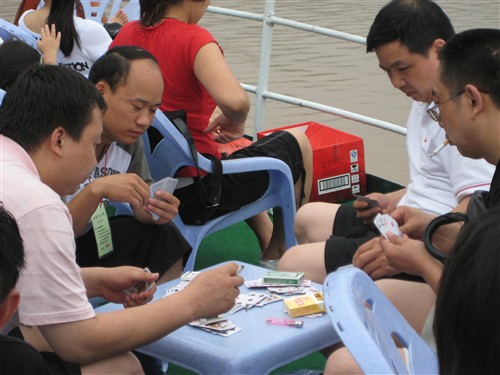 Back on the big boat, we endured the rest of our Yangzi River cruise amid more rain and dense fog. While we would NEVER endeavor to repeat the experience and would strongly discourage anyone else from doing so, we must confess the fascinating insight that we have gained into Chinese culture. After “vacationing” among a ship full of Chinese passengers, we have amassed a collection of observations. They love to play cards and the men smoke like chimneys. Yelling is a part of normal conversation. They hock up mucus and spit incessantly (probably from the pollution and smoking) and often on the floor. They laugh a lot and seem generally cheerful. They largely ignored our presence on the ship and when they did watch us, it was with curiosity rather than disdain. They generally woke early and slept away the afternoons. They smoke incessantly, seemingly oblivious to the fact that they are plaguing those around them with contaminated air. I tried to get the message across by strapping on a double-layer of hospital masks whenever they lit up in my presence but it had no effect. Hopefully, the masks limited the cancer-causing filth that infiltrated my shrine.
Back on the big boat, we endured the rest of our Yangzi River cruise amid more rain and dense fog. While we would NEVER endeavor to repeat the experience and would strongly discourage anyone else from doing so, we must confess the fascinating insight that we have gained into Chinese culture. After “vacationing” among a ship full of Chinese passengers, we have amassed a collection of observations. They love to play cards and the men smoke like chimneys. Yelling is a part of normal conversation. They hock up mucus and spit incessantly (probably from the pollution and smoking) and often on the floor. They laugh a lot and seem generally cheerful. They largely ignored our presence on the ship and when they did watch us, it was with curiosity rather than disdain. They generally woke early and slept away the afternoons. They smoke incessantly, seemingly oblivious to the fact that they are plaguing those around them with contaminated air. I tried to get the message across by strapping on a double-layer of hospital masks whenever they lit up in my presence but it had no effect. Hopefully, the masks limited the cancer-causing filth that infiltrated my shrine.
Thankfully, we had a group of good-humored comrades with whom we could share and laugh our way through this bizarre cruise experience.
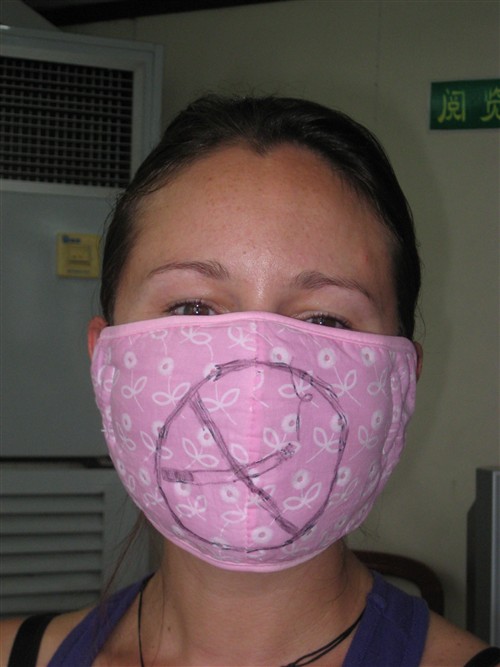 After our cruise on the Yangzi, we had a long, uncomfortable day of travel to Wuhan. Our cruise ship docked in Maoping where no English-speaking person could tell the group of confused- and frustrated-looking foreigners which public bus went to Yichang. By some miracle, we did make it onto the right bus and were delivered to the bus station in Yichang, where someone was supposed to be waiting with a sign. No such person was there so we dropped our bags on the front steps of the station and waited.
After our cruise on the Yangzi, we had a long, uncomfortable day of travel to Wuhan. Our cruise ship docked in Maoping where no English-speaking person could tell the group of confused- and frustrated-looking foreigners which public bus went to Yichang. By some miracle, we did make it onto the right bus and were delivered to the bus station in Yichang, where someone was supposed to be waiting with a sign. No such person was there so we dropped our bags on the front steps of the station and waited. A cruise on the Yangzi River had been touted as a must-do in China and, although we had so recently cruised in Halong Bay in Vietnam, our curiosity got the best of us. If you don’t speak Chinese, there is disappointingly scarce information available regarding the cruises, the highlight of which is the opportunity to view the famed Three Gorges. From our hostel in Xi’an, we were able to book cruises but the staff had little knowledge of the details. The two options: an international cruise ship – very expensive; or a Chinese cruise ship for less than a third of the price. The international cruise had provided a snazzy color brochure; the Chinese ship was a total mystery. Your Honor, if it pleases the court, I would like the record to reflect that I lobbied against the Yangzi River cruise altogether.
A cruise on the Yangzi River had been touted as a must-do in China and, although we had so recently cruised in Halong Bay in Vietnam, our curiosity got the best of us. If you don’t speak Chinese, there is disappointingly scarce information available regarding the cruises, the highlight of which is the opportunity to view the famed Three Gorges. From our hostel in Xi’an, we were able to book cruises but the staff had little knowledge of the details. The two options: an international cruise ship – very expensive; or a Chinese cruise ship for less than a third of the price. The international cruise had provided a snazzy color brochure; the Chinese ship was a total mystery. Your Honor, if it pleases the court, I would like the record to reflect that I lobbied against the Yangzi River cruise altogether.
 On the second morning, we cruised through Qutang Gorge, the first of the Three Gorges. The day was foggy and it was raining again – the visibility left much to be desired – but the Chinese passengers flooded the outer VIP deck nonetheless to pose for endless photos. All of our group donned their rain gear and wandered outside to join the melee…all except for me. I simply didn’t find the view interesting enough to stand in the rain before my first cup of coffee. The gorge was a range of green contoured rock formations, very similar to Milford Sound in New Zealand. The formations were impressive but shrouded in such thick mist that they were almost completely obscured. I remained inside the glassed-in area of the VIP lounge, enjoying the views from my insulated vantage point. Then suddenly I saw it…the saddest, most forlorn little Bear face peering at me through the glass; he was holding his camera and umbrella and getting soaked from the blowing rain. My heart broke for that little frown and I raced to the cabin to get my rain poncho. God help me if my children have faces like that.
On the second morning, we cruised through Qutang Gorge, the first of the Three Gorges. The day was foggy and it was raining again – the visibility left much to be desired – but the Chinese passengers flooded the outer VIP deck nonetheless to pose for endless photos. All of our group donned their rain gear and wandered outside to join the melee…all except for me. I simply didn’t find the view interesting enough to stand in the rain before my first cup of coffee. The gorge was a range of green contoured rock formations, very similar to Milford Sound in New Zealand. The formations were impressive but shrouded in such thick mist that they were almost completely obscured. I remained inside the glassed-in area of the VIP lounge, enjoying the views from my insulated vantage point. Then suddenly I saw it…the saddest, most forlorn little Bear face peering at me through the glass; he was holding his camera and umbrella and getting soaked from the blowing rain. My heart broke for that little frown and I raced to the cabin to get my rain poncho. God help me if my children have faces like that. The Chinese have very different ideas about snacks. We have often seen displays of dried fish and grotesque-looking cooked animal parts that sit out on tables all day. One of our most interesting finds at the supermarket was a pile of dried pig faces preserved in the same petrified manner as the pig ears sold for dogs in the States. Refreshments were available for purchase on the ship and a woman walked around the deck, peddling whole juvenile roasted chickens from a bucket. The whole skewered birds couldn’t have had more meat on them than an average drumstick but I was dying to see someone eat one. There were no takers in our group despite my repeated double dares.
The Chinese have very different ideas about snacks. We have often seen displays of dried fish and grotesque-looking cooked animal parts that sit out on tables all day. One of our most interesting finds at the supermarket was a pile of dried pig faces preserved in the same petrified manner as the pig ears sold for dogs in the States. Refreshments were available for purchase on the ship and a woman walked around the deck, peddling whole juvenile roasted chickens from a bucket. The whole skewered birds couldn’t have had more meat on them than an average drumstick but I was dying to see someone eat one. There were no takers in our group despite my repeated double dares. Back on the big boat, we endured the rest of our Yangzi River cruise amid more rain and dense fog. While we would NEVER endeavor to repeat the experience and would strongly discourage anyone else from doing so, we must confess the fascinating insight that we have gained into Chinese culture. After “vacationing” among a ship full of Chinese passengers, we have amassed a collection of observations. They love to play cards and the men smoke like chimneys. Yelling is a part of normal conversation. They hock up mucus and spit incessantly (probably from the pollution and smoking) and often on the floor. They laugh a lot and seem generally cheerful. They largely ignored our presence on the ship and when they did watch us, it was with curiosity rather than disdain. They generally woke early and slept away the afternoons. They smoke incessantly, seemingly oblivious to the fact that they are plaguing those around them with contaminated air. I tried to get the message across by strapping on a double-layer of hospital masks whenever they lit up in my presence but it had no effect. Hopefully, the masks limited the cancer-causing filth that infiltrated my shrine.
Back on the big boat, we endured the rest of our Yangzi River cruise amid more rain and dense fog. While we would NEVER endeavor to repeat the experience and would strongly discourage anyone else from doing so, we must confess the fascinating insight that we have gained into Chinese culture. After “vacationing” among a ship full of Chinese passengers, we have amassed a collection of observations. They love to play cards and the men smoke like chimneys. Yelling is a part of normal conversation. They hock up mucus and spit incessantly (probably from the pollution and smoking) and often on the floor. They laugh a lot and seem generally cheerful. They largely ignored our presence on the ship and when they did watch us, it was with curiosity rather than disdain. They generally woke early and slept away the afternoons. They smoke incessantly, seemingly oblivious to the fact that they are plaguing those around them with contaminated air. I tried to get the message across by strapping on a double-layer of hospital masks whenever they lit up in my presence but it had no effect. Hopefully, the masks limited the cancer-causing filth that infiltrated my shrine.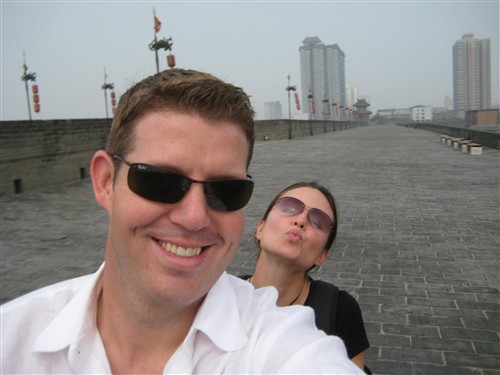 Giant, cuddly, loveable pandas, or panders as the Chinese call them, were on the itinerary for our third day in Xi’an. We hired a driver from our hostel to make the two hour drive to a WWF (World Wildlife Federation)-sponsored wildlife sanctuary.
Giant, cuddly, loveable pandas, or panders as the Chinese call them, were on the itinerary for our third day in Xi’an. We hired a driver from our hostel to make the two hour drive to a WWF (World Wildlife Federation)-sponsored wildlife sanctuary.
 Discovered by accident in 1974 by peasants digging a well, the Army of Terracotta Warriors is one of most important discoveries of ancient Chinese history. Commissioned by Qin Shi Huang, the First Emperor of China, the army of thousands of life-size soldiers in battle formation stands guard at the emperor’s tomb. Some say Qin Shi Huang feared evil spirits in the afterlife while others believe that he expected his rule to continue after death. Ancient scholars seem to agree that the emperor was paranoid and fanatical, which would explain his obsession with creating a “pretend” army. Whatever the case, the army of soldiers, when viewed in its partially restored state, is undeniably impressive.
Discovered by accident in 1974 by peasants digging a well, the Army of Terracotta Warriors is one of most important discoveries of ancient Chinese history. Commissioned by Qin Shi Huang, the First Emperor of China, the army of thousands of life-size soldiers in battle formation stands guard at the emperor’s tomb. Some say Qin Shi Huang feared evil spirits in the afterlife while others believe that he expected his rule to continue after death. Ancient scholars seem to agree that the emperor was paranoid and fanatical, which would explain his obsession with creating a “pretend” army. Whatever the case, the army of soldiers, when viewed in its partially restored state, is undeniably impressive.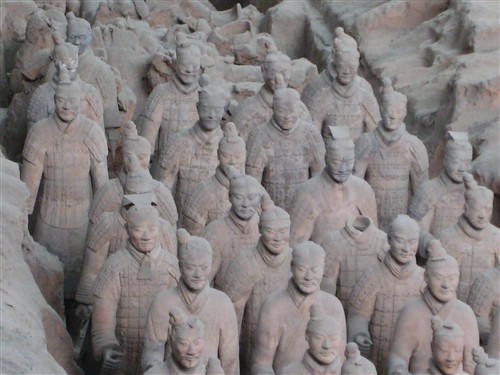 The excavation sites each showed the broken condition in which the soldiers were discovered. A sign near one of the pits indicated that, to date, not a single statue has been unearthed intact. When we reached Pit 1, where approximately 6,000 soldiers are thought to stand (although only 2,000 have been restored to date), we met with the postcard view of the Terracotta Army. The excavation site was larger than a regulation football field and less than half of the site had been fully excavated; the two-thousand restored warriors, dating back to 210 B.C., stood stoically in battle formation with horses and all. As we stood facing the front line, it was easy to imagine the army in its full grandeur and completion with Emperor Qin Shi Huang pacing back and forth, barking orders at his earthen men.
The excavation sites each showed the broken condition in which the soldiers were discovered. A sign near one of the pits indicated that, to date, not a single statue has been unearthed intact. When we reached Pit 1, where approximately 6,000 soldiers are thought to stand (although only 2,000 have been restored to date), we met with the postcard view of the Terracotta Army. The excavation site was larger than a regulation football field and less than half of the site had been fully excavated; the two-thousand restored warriors, dating back to 210 B.C., stood stoically in battle formation with horses and all. As we stood facing the front line, it was easy to imagine the army in its full grandeur and completion with Emperor Qin Shi Huang pacing back and forth, barking orders at his earthen men.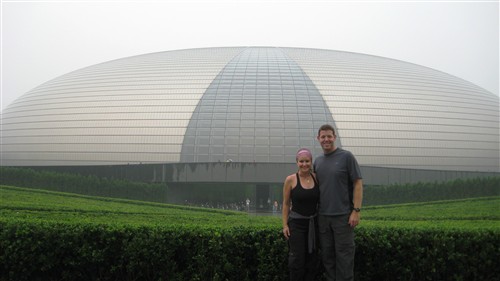
 The Beijing National Stadium, a.k.a. the Bird’s Nest for its architecture, will be the site of the opening and closing ceremonies of the 2008 Summer Olympic Games as well as the main track and field events. The area around the Bird’s Nest was fenced off so we could not get very close to it. We had the driver stop for a few minutes along the side of the road so that we could join the other gawkers. The building was a massive display of modern architecture, in which soaring curvature has replaced the maximum functionality of space as the primary initiative of the endeavor. The gargantuan steel structure invokes shock and awe in the beholder rather than admiration of beauty in the traditional sense. It is inarguably an impressive artistic and architectural feat.
The Beijing National Stadium, a.k.a. the Bird’s Nest for its architecture, will be the site of the opening and closing ceremonies of the 2008 Summer Olympic Games as well as the main track and field events. The area around the Bird’s Nest was fenced off so we could not get very close to it. We had the driver stop for a few minutes along the side of the road so that we could join the other gawkers. The building was a massive display of modern architecture, in which soaring curvature has replaced the maximum functionality of space as the primary initiative of the endeavor. The gargantuan steel structure invokes shock and awe in the beholder rather than admiration of beauty in the traditional sense. It is inarguably an impressive artistic and architectural feat.
 Our duck arrived after about thirty minutes and the chef began carving it up. Due to my little carcass phobia, I kept my eyes on Aaron and prayed that nothing that arrived at the table would resemble a living animal or its internal organs. We were served a few slivers of flavorful skins first, which we happily doused in plum sauce. Next, the sliced meat was presented in an expertly carved pile. Thankfully, the carcass was then taken away. The waitress demonstrated the traditional assembly for Peking duck by dipping two pieces of meat into the plum sauce and placing them in the center of one of the rice pancakes. She then added a sliver of spring onion and a julienne cucumber and folded the pancake neatly around the filling, using my chopsticks. Dinner was delicious! We finished just in time to race back to the hostel, collect our bags, and head to the train station.
Our duck arrived after about thirty minutes and the chef began carving it up. Due to my little carcass phobia, I kept my eyes on Aaron and prayed that nothing that arrived at the table would resemble a living animal or its internal organs. We were served a few slivers of flavorful skins first, which we happily doused in plum sauce. Next, the sliced meat was presented in an expertly carved pile. Thankfully, the carcass was then taken away. The waitress demonstrated the traditional assembly for Peking duck by dipping two pieces of meat into the plum sauce and placing them in the center of one of the rice pancakes. She then added a sliver of spring onion and a julienne cucumber and folded the pancake neatly around the filling, using my chopsticks. Dinner was delicious! We finished just in time to race back to the hostel, collect our bags, and head to the train station.